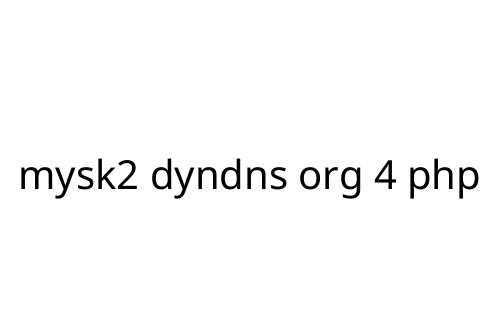mysk2 dyndns org 4 php
If you've been searching for information on "mysk2 dyndns org 4 php," you're likely interested in dynamic DNS solutions, particularly the services offered by the mysk2 subdomain through DynDNS, and how to use this with PHP scripts or applications. Let’s break down what you need to know, step by step, with practical advice you can use.
What is mysk2 dyndns org 4 php?
Put simply, mysk2.dyndns.org is a dynamic DNS hostname. Dynamic DNS (DDNS) lets you point a subdomain (like mysk2.dyndns.org) to a changing IP address—usually your home internet IP, which isn’t static. This makes remote access possible even if your IP address shifts.
Adding "4 php" to your query suggests you’re looking for ways to use or access mysk2.dyndns.org within a PHP application. Maybe you want your PHP script to connect to a server or database that's accessible via this DynDNS URL, or perhaps you plan to update records, send data, or automate access.
Common Use Cases
Using DynDNS with PHP is common among:
- Home server owners, accessing web interfaces remotely
- Developers automating database or file transfers
- People monitoring devices (like webcams, IoT, or security systems) behind changing IPs
PHP, as a scripting language, can handle HTTP requests, parse responses, and interface with many devices or APIs that sit behind a DynDNS address.
Setting It Up
1. Ensure DynDNS is Active:
You first need a working mysk2.dyndns.org address. Register on the DynDNS platform (now mostly commercial, but other dynamic DNS providers exist) and configure your router or a software client to keep the IP updated.
2. Using PHP to Access DynDNS Resources:
PHP can access services at mysk2.dyndns.org the same way as with any other public hostname. For example:
<?php
// Example: Reading remote data
$data = file_get_contents('http://mysk2.dyndns.org/api/endpoint');
echo $data;
?>
Replace the URL with the path relevant to your setup.
3. Security Considerations:
- Make sure you’re connecting over HTTPS whenever possible.
- Use authentication (tokens, passwords) to prevent unauthorized access.
- Validate input/output to avoid injection or abuse if you’re exposing PHP scripts to the internet.
Pros and Cons
Pros:
- No need for a static IP from your ISP, which can cost extra.
- Allows for flexible, remote access to home or small business resources.
- PHP’s compatibility lets you automate tasks or create custom dashboards easily.
Cons:
- DynDNS services like Dyn.com moved to paid-only models. Alternatives may vary in reliability.
- Exposing home resources increases security risks. Proper configuration and updates are crucial.
- Internet outages or DNS update delays may limit accessibility.
Practical Tips
- Test access to mysk2.dyndns.org from both local and remote networks.
- Schedule PHP routines to verify address resolution; use error handling for downtime.
- Review logs for unauthorized attempts if exposing PHP interfaces beyond your LAN.
In Summary
"mysk2 dyndns org 4 php" refers to using a DynDNS-provided hostname in conjunction with PHP scripts or applications. This setup is great for anyone wanting remote access or automation without a static IP. Just keep security and reliability in mind, and you’ll open up a world of flexible, remote PHP-powered solutions.


 Taj Mackinolty – Author
Taj Mackinolty is a seasoned gambling enthusiast and writer at Smart Gamble Land. With a sharp focus on betting systems and winning strategies, Taj delivers clear and actionable content to readers looking to improve their gambling skills. His deep analytical approach and understanding of risk management allow him to break down complex techniques into simple guides. Taj is passionate about helping players gain control over their betting habits and develop a strategic mindset that can lead to long-term success in the casino environment.
Taj Mackinolty – Author
Taj Mackinolty is a seasoned gambling enthusiast and writer at Smart Gamble Land. With a sharp focus on betting systems and winning strategies, Taj delivers clear and actionable content to readers looking to improve their gambling skills. His deep analytical approach and understanding of risk management allow him to break down complex techniques into simple guides. Taj is passionate about helping players gain control over their betting habits and develop a strategic mindset that can lead to long-term success in the casino environment.
